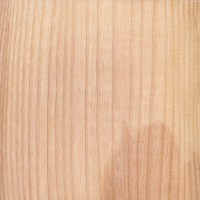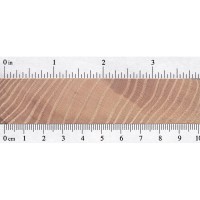 |
Common Name(s): European Ash, Common Ash Scientific Name: Fraxinus excelsior Distribution: Europe and southwestern Asia Tree Size: 65-115 ft (20-35 m) tall, 3-6 ft (1-2 m) trunk diameter Average Dried Weight: 42 lbs/ft3 (680 kg/m3) Specific Gravity (Basic, 12% MC): .49, .68 Janka Hardness: 1,480 lbf (6,580 N) Modulus of Rupture: 15,020 lbf/in2 (103.6 MPa) Elastic Modulus: 1,785,000 lbf/in2 (12.31 GPa) Crushing Strength: 7,400 lbf/in2 (51.0 MPa) Shrinkage: Radial: 5.7%, Tangential: 9.6%, Volumetric: 15.3%, T/R Ratio: 1.7 |
Color/Appearance: The heartwood is a light to medium brown color, though darker streaks can also be seen, which is sometimes sold as Olive Ash. Sapwood can be very wide, and tends to be a beige or light brown; not always clearly or sharply demarcated from heartwood.
Grain/Texture: Has a medium to coarse texture similar to oak. The grain is almost always straight and regular, though sometimes curly or figured boards can be found.
Endgrain: Ring-porous; large earlywood pores 2-4 rows wide, small latewood pores solitary and radial multiples of 2-3; tyloses common; growth rings distinct; rays barely visible without lens; parenchyma banded (marginal), paratracheal parenchyma around latewood pores vasicentric, aliform, and confluent.
Rot Resistance: Heartwood is rated as perishable, or only slightly durable in regard to decay. Ash is also not resistant to insect attack.
Workability: Produces good results with hand or machine tools. Responds well to steam bending. Glues, stains, and finishes well.
Odor: Gives off a distinct, moderately unpleasant smell when being worked.
Allergies/Toxicity: Ash in the Fraxinus genus has been reported to cause skin irritation, and a decrease in lung function. See the articles Wood Allergies and Toxicity and Wood Dust Safety for more information.
Pricing/Availability: European Ash is the European equivalent to White Ash of the United States, and both should be among the least expensive utility hardwoods available domestically, respectively. It should compare similarly to oak in terms of price.
Sustainability: This wood species is not listed in the CITES Appendices or on the IUCN Red List of Threatened Species.
Common Uses: Flooring, millwork, boxes/crates, baseball bats, and other turned objects such as tool handles.
Comments: European Ash has fairly good strength properties for its weight, and is also shock resistant.
When stained, ash can look very similar to oak (Quercus spp.), although oaks have much wider rays, which are visible on all wood surfaces—even on flatsawn surfaces, where they appear as short, thin brown lines between the growth rings. Ashes lack these conspicuous rays.
Scans/Pictures: A special thanks to Steve Earis for providing the wood sample and turned photo of this wood species.










Is European ash leaves or the wood toxic to Conyer birds
My favorite wood for working with hand tools. It’s strong, much easier to work than Oak, it doesn’t tear out during hand-planing, takes a great finish…
It’s the wood the army of Macedonia used for their long pikes (sarissas)
A very nice wood to work, quite a bit heavier than its American cousin. Most people find its smell pleasant when it’s being worked. Here in France, it pretty much defines what a cabinet maker’s workshop used to smell like, before MDF took over.
It is a tough, sturdy wood that doesn’t like screws very much. My dad, who’s also a beekeeper, taught me to rub the screws in beeswax to avoid stripping them.
It takes a very nice, golden hue when finished with shellac.